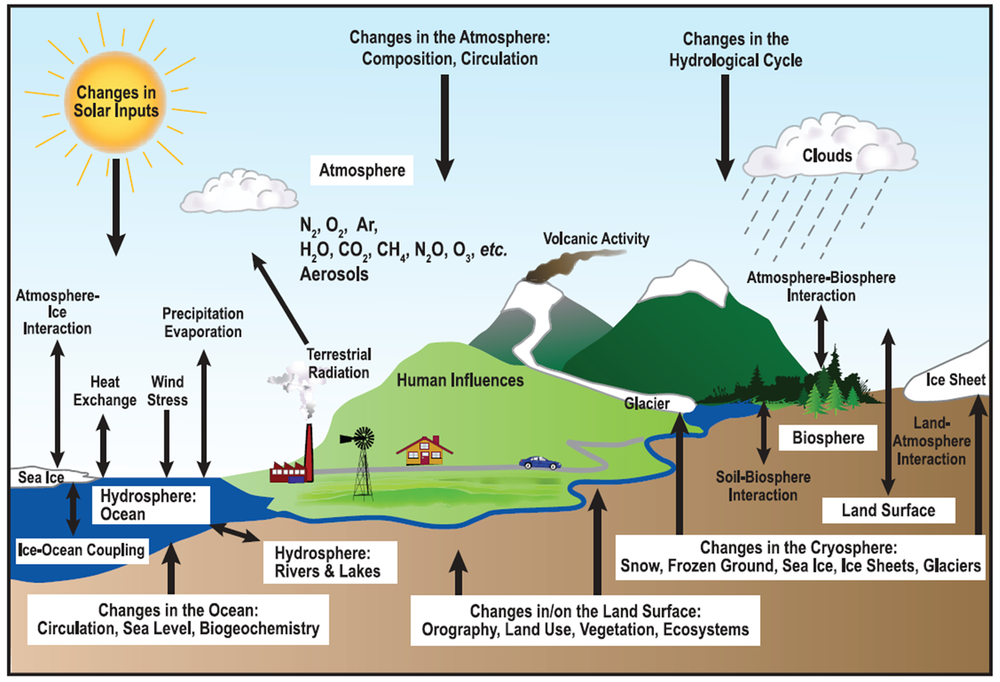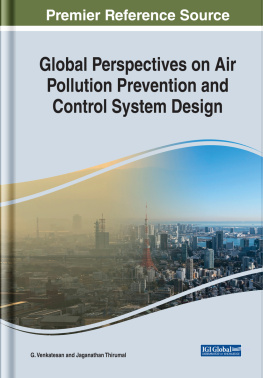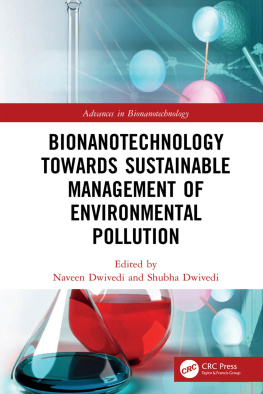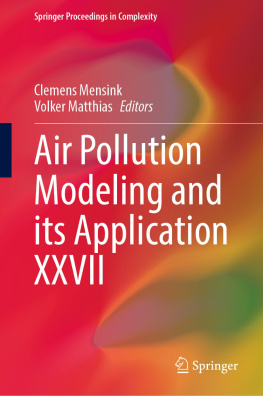Chapter 1
Air Pollution and Climate Change:
Relationship Between Air Quality and Climate Change
- Ashok Kumar
The University of Toledo, USA - Hamid Omidvarborna
The University of Toledo, USA - Kaushik K. Shandilya
The University of Toledo, USA
ABSTRACT
Climate records kept worldwide clearly show that ongoing changes are happening in our eco-systems. Such climate changes include temperature, precipitation, or sea level, all of which are expected to keep changing well into the future, thereby affecting human health, the environment, and the economy. The natural causes by themselves are not able to describe these changes, so to understand these, scientists are using a combination of state-of-the-science measurements and models. Human activities are a major contributor due to the release of different air contaminants through various activities. Air pollution is one case-in-point, a human-made factor that contributes to climate change by affecting the amount of incoming sunlight that is either reflected or absorbed by the atmosphere. An overview of modeling techniques used to relate air quality and climate change is presented. The discussion includes the role of air pollution levels affecting the climate. Emerging topics such as black carbon (BC), fine particulate matters (PMs), role of cook stove, and risk assessment are also covered.
INTRODUCTION
It is important to understand climate in order to study climate change, which includes the harm caused by air pollutants. These can occur through natural processes or through human activities, which in turn affect human health and the ecosystem, resulting in millions of annual premature deaths, and hospitalizations (Schreiner et al., 2006; Shandilya and Khare, 2012). Further, climate change highly impacts on agriculture and fisheries (farmers and ranchers). Increases in temperature and CO2 level in the atmosphere can change in the frequency and severity of droughts and floods, which can threat food safety. In addition, warmer water temperatures are likely to cause the habitat ranges of many fish and shellfish species to shift, which could disrupt ecosystems (USEPA, 2018a).
Climate change is able to alter how primary pollutants are dispersed and to intensify secondary pollutant formation. Therefore, it is helpful to review the impact of climate change. In particular, it is necessary to note that there is a relation between weather and climate. Weather is defined as the state of the atmosphere at any given time and place, while climate is the long-term average (e.g., decades) of the weather in any place (Rosenzweig et al., 2001). Figure 1 shows the relationship between the weather variability and climate change (Solomon et al., 2007).
| Figure 1. Schematic view of the major components of the climate system, main processes and key interactions |
|---|
 |
| Source: Solomon et al. (2007) |
As shown in Figure 1, the climate system is comprised of five natural components, (1) the atmosphere, (2) the hydrosphere, (3) the cryosphere, (4) the land surface, and (5) the biosphere.
The atmosphere includes gases that surrounds Earth, including the naturally occurring greenhouse gases or GHGs that warm the planets surface. The hydrosphere includes all of Earths liquid and gaseous water (water vapor), while the cryosphere includes all frozen water (ice). The land surface only consists of all vegetated and non-vegetated surfaces. The biosphere is the global ecological system integrating all living beings and their relationships.
Several external forces influence the five climate system components, with radiation from the Sun being most important. The Sun is the primary energy source for Earths climate. Some incoming sunlight is reflected into space (via bright surfaces like ice and clouds), while the rest is absorbed by the surface and the atmosphere. A considerable amount of this absorbed solar energy is re-emitted as heat through long-wave or infrared radiation, but some heat escapes when the atmosphere absorbs and re-radiates heat. Disturbing this balance (incoming and outgoing energy) results in climate change (Wittneben and Kiyar, 2009). Additionally, climate scientists consider the impact of human activities on the climate system as another example of external forcing.
The instability of the atmosphere within the climate system is evident in how it is composed of nitrogen, oxygen, and argon with 78.1, 20.9, and 0.93% vol. mixing ratio, respectively. In the atmosphere, these three elements have limited interaction with the solar radiation and do not interact with long-wave or infrared radiation. Also, GHGs (e.g. water vapor, CO2, CH4, O3, and N2O (<0.1% by volume)), can absorb and emit these radiations keeping Earths surface and lower atmosphere warm. Likewise, solid and liquid particles (aerosols) interact with radiation in a complex and spatial manner (Shandilya et al., 2009).
The oceans are also crucial as they are able to store energy and CO2. The ice sheets (of Greenland and Antarctica), continental glaciers, snowfields, sea ice and permafrost derive their importance to the climate system through high reflectivity for solar radiation, low thermal conductivity, large thermal inertia, and the driving of deep ocean water circulation. Forests play a major role on the atmospheres composition as they store large amounts of CO2 through the photosynthetic process. Vegetation and soils control energy balance (received from the Sun and returned to the atmosphere) while serving to evaporate water (either in the soil or in the leaves of plants). By considering all those factors, it can be concluded that life could not have evolved without this greenhouse effect; however, human activities (through emitting GHGs and changing the nature of the land surfaces) have altered Earths climate balance toward warming, with the biggest contributor being increases in CO2 (Wittneben and Kiyar, 2009).
Regardless of natural effects, climate change and air pollution are still united by human emissions. Climate system factors, their processes and fundamental interactions (as explained above) have been affected because of air pollution. The concentration levels of atmospheric pollutants have increased significantly since the Industrial Revolution. The atmospheric concentrations of CO2, CH4, and N2O have increased since pre-industrial times by about 40, 150, and 20%, respectively. More than half of the increase in CO2 has been released since 1970. Increases in all these gases contribute to climate change, with an especially huge impact by CO2.
Climate pollutant types (both short- and long-lived) vary in their reactivity. Short-lived climate pollutants are defined as particles that contribute to warming; the duration typically ranges from a few days to a full decade. Table 1 summarizes the residence time of different air contaminants released in the atmosphere because of human activities as well as their major sources. The residence time is how long it takes for an air contaminant to be removed from the atmosphere. For example, the residence time of N2O is about 120 years, while for BC it is a few weeks. Short-lived climate pollutants are known to cause greater impacts and can be extremely potent in terms of their GWP compared to long-lived climate pollutants.
Human activities are responsible for almost all of the increase in GHGs in the atmosphere over the last 150 years (Kahn Ribeiro et al., 2007). The largest source of greenhouse gas emissions from human activities in the US is from burning fossil fuels for electricity, heat, and transportation (USEPA, 2018b.








